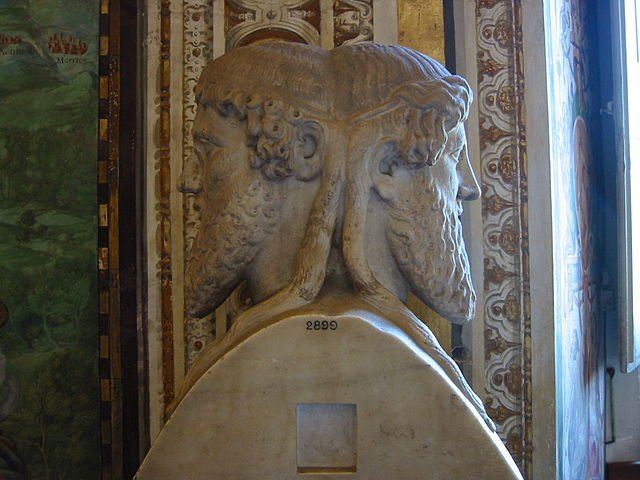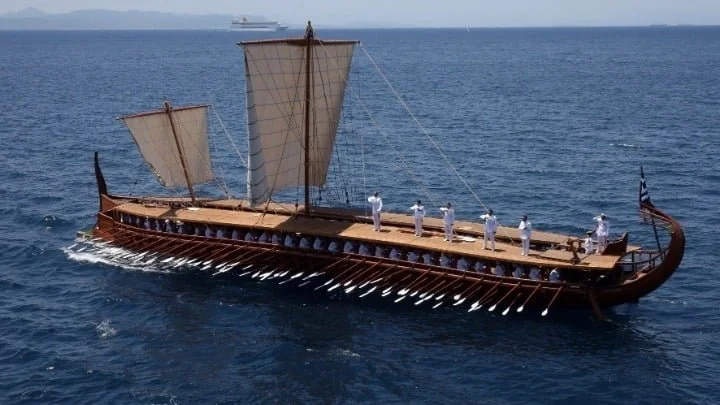Heads or Ships-Random Decision Making in Roman Times
By Manon Post
The Trireme OLYMPIAS
In common parlance, heads or tails is called for when one of two options cannot be chosen over the other by means of rational logic or emotional preference.
This terminology is used because of the prolific usage of a profile portrait on the obverse of modern coinage, with tails simply meaning the opposite of the head. However, this practice has not always had this name. First noted in the 3rd century BCE, the Romans called this game ‘capita aut navia’, meaning heads or ships, and both its invention and its name are shrouded in mystery. In shedding light on the question of the name, the first point to make is that unfortunately the reverse side of Roman coinage did not always or even often depict a ship. However a worthwhile afternoon of research on the origin of the name of this game, produced the following .
In the 5th century CE, some seven hundred years after the game’s invention, a philosopher called Macrobius wrote a series of dialogues set at a fictional dinner party in celebration of the Saturnalia. In one of these dialogues, an attendee jokingly explains why young men gamble with cries of ‘heads or ships’. The set up to this no doubt hilarious to a Roman punchline, describes Saturn coming ashore from a voyage and visiting Janus (both are Roman gods) where Saturn imparts his agricultural knowledge and introduces Janus to fruit. Janus, thrilled with the improvement fruit makes to his life, shows his gratitude by giving Saturn a share of his kingship and in the coinage Janus goes on to mint, he preserves the imagery of Saturn, either by his likeness on the obverse or by depicting the prow of his ship on the reverse (Macrobius, Saturnalia, 1.7.21).
There are obviously some problems in matching this mythological story to an actual coinage that could have inspired the game of Heads or Ships – the main one being that it is a myth and therefore the coinage described was not minted. Having said that, the coinage this game was named for and which Macrobius could be indirectly referencing (he would never have seen these coins himself) is largely agreed to be a type of coin called the aes grave. This is a bronze coin minted in the 3rd Century BCE when Rome was a republic, depicting Janus on the obverse and the prow of a wooden ship on the reverse and it is this imagery that named the game, although its existence on this coinage is not for the reasons Macrobius describes.
Aes grave – courtesy of the American Numismatic Society
Janus is the god who gives us the name for the month of January, his primary fame is as the god of doors or gateways, and beginnings and endings. In the sphere of public Roman religion this was often associated with the beginnings and endings of military conflict – in fact the doors of his temple only closed when the territories of Rome were all at peace. In visual media, he is usually depicted with two heads or faces pointing in opposite directions and his presence on coinage is not surprising. Deities are common choices for minting authorities throughout antiquity, and imagery associated with either military victory or bringing about peace was powerful propaganda for those in charge.
Bust of Janus – Wikimedia commons
It is possible the prow on the reverse does represent the boat of Saturn from Macrobius’ tale. It is however far more likely that the prow is also a representation of the recent naval success of Rome over Carthage in the first Punic War. While at this stage of its history Rome was not a significant naval power, victory in this twenty three year war fought in the waters around Sicily and further south on the coast of modern day Libya and Tunisia was a stunning achievement for a Republic with territorial ambitions beyond Italy. This, combined with Janus’s image often being used to depict peace won through war explains why this imagery was chosen by the authorities who wished to advertise this success.
There are also less interpretative, more practical reasons as to why this coin is a likely source of inspiration for the name. It is a common coin, not just because it was made of bronze, which is the material of coins used in daily life, but because it also makes up one of every four coin types found in excavations at Pompeii, which suggests it was heavily used. Therefore it would have been familiar to the gamblers who created this game. And there is the name itself. We do not take any notice of the plural these days, despite the fact we are talking about one head or one tail, but on the aes grave, they were talking of two heads (admittedly on one god) and a prow that stood for an entire navy.
So while the suggestion that the games name is inherited from gratitude for divine agricultural advice delivered by the seafaring Saturn is a romantic one, the archaeological and historical evidence points in a slightly different direction. However if you are undecided on whether to believe the mythology or the archaeology, you can always decide which to endorse with a coin toss.
Notes on the Boats
The ships of the Roman navy were most likely triremes or possibly quinqueremes, very similar to the triremes that had made the Athenians a truly terrifying naval power over two hundred years earlier. The archaeological evidence for the first Punic War, most importantly 19 bronze warship rams recovered from the seabed, supports the conclusion that the boats were triremes, however they all come from the Battle of Aegates Island, and it is possible the quinqueremes, described in the historic accounts of the time period were simply deployed elsewhere at that moment.
Bronze Ram – Wikimedia commons
Experimental archaeology led to the reconstruction of an Athenian trireme in the mid 1980s under the naval architect John F. Coates in collaboration with a number of historians and archaeologists. Olympias, the result of the project, provides the most accurate assessment of how these boats operated available. 37m long, with a 47 tonne displacement, she was propelled by two large, square sails and 170 oarsmen sat on three levels, giving the boat its name. In sea trials with a mixed gender and inexperienced crew, she reached speeds of nine knots, and could turn 180 degrees in under a minute inside an arc of 2 and a half ship lengths.
The Trireme OLYMPIAS
Triremes are described by ancient historians, most notably the military historian and trireme commander Thucydides, as fast, nimble, and manoeuvrable ships despite their length (Thucydides, History of the Peloponnesian War, 4.104.4-5; 4.106.3) and Olympias is a good example of this. Given the inexperienced nature of her crew during sea trials, it is likely that these ships may have been capable of reaching a 16 knot ramming speed with a highly trained male crew. They are also technically very impressive. To negate the bending of the long thin ship when under stress a tight hemp rope (hypozomata) ran beneath the deck from bow to stern – an early example of pretensioning.
Manon Post is a PhD candidate in Ancient History at Leiden University, specialising in the numismatic and economic history of the Ptolemaic Period. Growing up in a family with various sailing obsessed members she was coerced into sailing dinghies as a child in the UK but found her real interest in the sea lay in keelboats and as a teenager and young adult has crewed on various boats, wooden and otherwise, in New Zealand and Australia.





